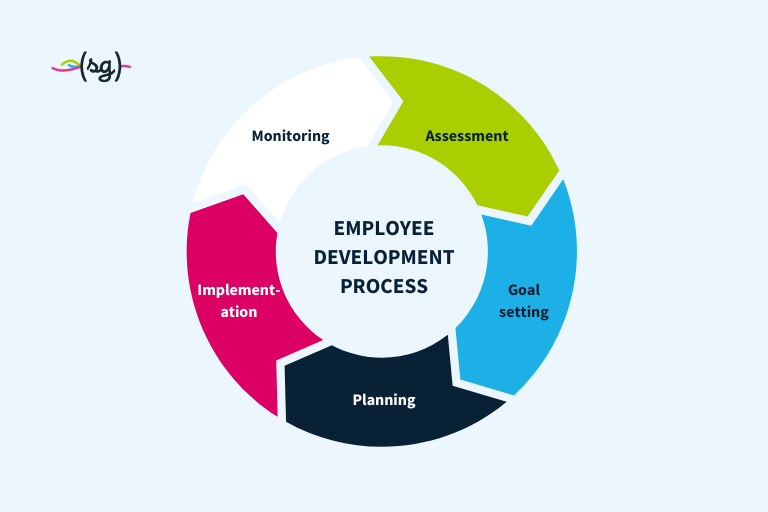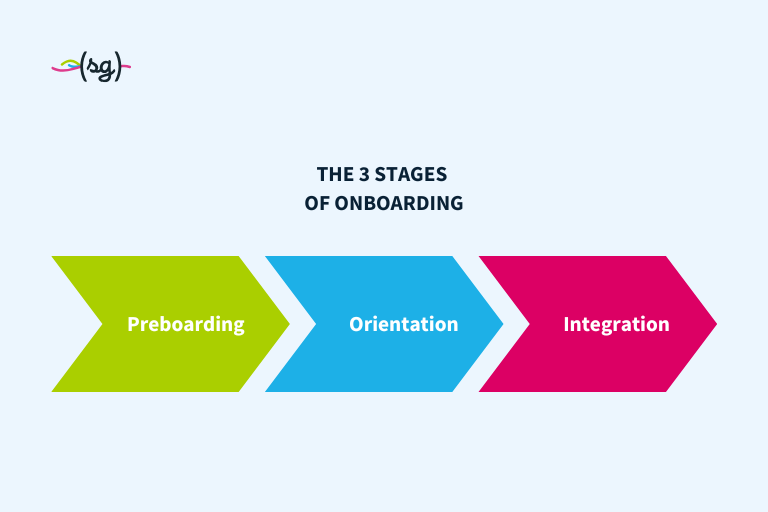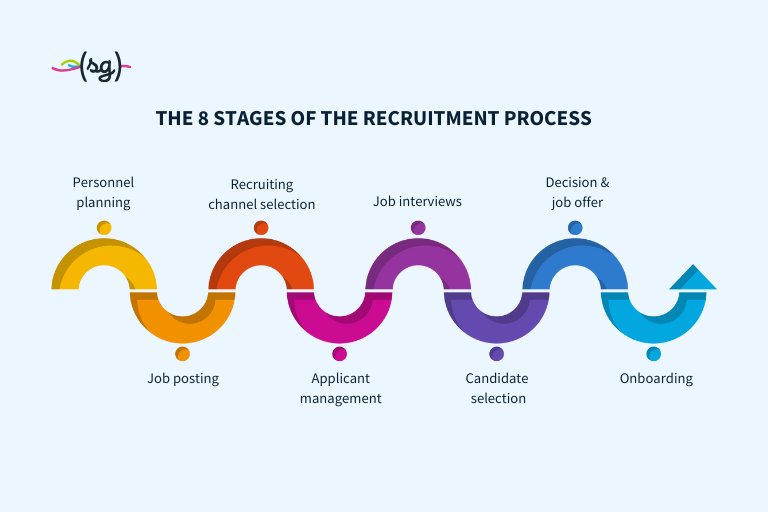In view of the growing shortage of skilled workers, it is becoming increasingly important for companies to present themselves as an attractive employer. In the war for talent, traditional recruiting methods are often not enough to attract the best talent. The solution: employer branding.
But what exactly does this term mean? We give you a clear overview of the topic of employer branding. We explain the definition, the objectives of employer branding and specific measures you can take to strengthen your employer brand.
Contents
- Employer branding definition
- Roles in the employer branding process
- Employer branding objectives: What are the benefits of an employer branding strategy?
- Internal and external employer branding
- Employer branding vs. recruitment marketing: what’s the difference?
- The employer branding process: step by step to a strong employer brand
- Employer branding measures: Best practices for maximum success
- Employer branding with softgarden: Strengthen your employer brand in recruiting
- FAQ – Employer branding
Employer branding definition
Employer branding, also known as employer brand management, encompasses all of a company’s activities to present itself as an attractive employer.
Employer branding aims to draw the attention of potential applicants to the company and improve the candidate experience in the recruitment process. At the same time, it helps to retain existing employees at the company in the long term.
In essence, this is what it is all about :
- Communicate the company’s culture, values and working conditions authentically both internally and externally
- To convey a positive and consistent image of the company to the relevant target group
- Stand out from the competition and inspire talent for your own company
Roles in the employer branding process
Designing and managing the employer brand are not one-off measures, but must be carried out permanently and strategically. In order to be successful in the long term, various departments in the company must be involved in the process and work together.
Human Resources
HR plays a central role as it is responsible for recruiting and retaining staff. They develop and implement the employer branding strategy and work closely with other departments.
Marketing and communication
These departments contribute their expertise in the areas of brand management, communication and addressing target groups. They create the messages and content that convey the employer brand to the outside world.
Management
The management level must recognize and support the importance of the employer brand. It sets the strategic direction and provides the necessary resources.
Employees
Your own employees are the best ambassadors for your employer brand. Their personal experience with the corporate culture and their identification with the company’s values and goals play a key role in shaping an employer’s external reputation.
A positive corporate culture that is characterized by factors such as recognition, feedback, development opportunities and a clear cultural fit motivates employees to actively recommend their company and thus contribute to attracting new talent.
Other participants in the employer branding process
Depending on the company and industry, other departments such as IT, sales or product development can also be involved. It is important to take a holistic approach that includes all relevant areas.
Employer branding objectives: What are the benefits of an employer branding strategy?
The aim of employer branding is to convey an attractive, credible and unmistakable image of a competent employer both internally and externally.
Implementing a well thought-out employer branding strategy offers companies numerous benefits:
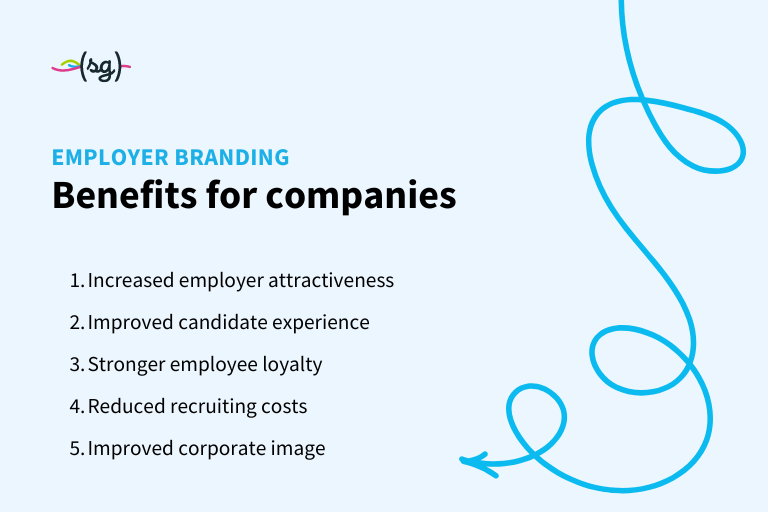
Increasing employer attractiveness
A strong employer brand makes companies more attractive to qualified specialists. In times of the war for talent, this is a decisive competitive advantage.
Improving the candidate experience
The candidate experience describes all the experiences applicants have during the application process. This ranges from the job search to the signing of the contract.
If these are predominantly positive, this ensures that candidates decide in favor of the company and recommend it to others.
Strengthening employee loyalty
Satisfied employees who identify with the company stay longer. They actively contribute to the company’s success.
Reduction of recruiting costs
An attractive employer brand often makes expensive job advertisements superfluous, as candidates actively apply to the company.
Improvement of the corporate image
Good employer branding not only improves the company’s image among potential applicants. It also makes the company more attractive to investors and business partners.
Internal and external employer branding
Employer branding can be divided into two areas:
Internal employer branding
The internal management of the employer brand is aimed at the company’s own employees. It aims to strengthen identification with the company. It also aims to increase motivation and commitment, thereby improving employee retention.
Internal employer branding examples are:
- Shaping an employee-oriented corporate culture
- Promotion of further training and development opportunities as part of employee development
- Flexible working time models and home office arrangements
- Attractive remuneration models and benefits
- Regular employee surveys and feedback meetings
External employer branding
External management of the employer brand is aimed at potential applicants. It aims to increase awareness of the company as an employer. It also aims to build a positive image and attract qualified candidates for open positions.
External employer branding examples are:
- Design of an appealing career page
- Presence in relevant social media
- Participation in career fairs and recruiting events
- Storytelling: testimonials from employees, insights into everyday working life
- Employer rating platforms such as Kununu or Glassdoor
Employer branding vs. recruitment marketing: what’s the difference?
The terms employer branding and recruitment marketing are often used interchangeably. However, there are actually some important differences.
Employer branding focuses on strategic and long-term measures to shape the employer brand.
Recruitment marketing deals with short and medium-term operational measures. These are intended to help fill vacancies. The focus here is on approaching and recruiting new employees.
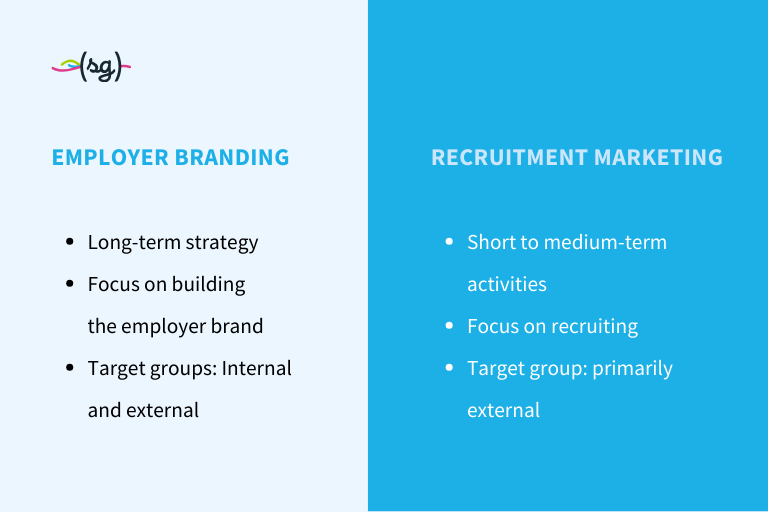
Employer branding
- Long-term strategy for positioning as an attractive employer
- Focus on the development of an authentic employer brand
- Includes both internal and external measures
Recruitment marketing
- Short to medium-term measures to recruit new employees
- Primarily aimed at external target groups
- Focus on filling vacancies
Employer branding creates a positive image as an employer. Recruitment marketing builds on this. It uses targeted measures to approach and recruit suitable candidates. Employer branding therefore forms the foundation for successful recruitment marketing.
The employer branding process: step by step to a strong employer brand
The employer branding process can be divided into four to five phases, which are run through repeatedly. The fifth phase represents the start of a new process cycle, which results in a constant review, adjustment and optimization of the employer brand.
This iterative approach is necessary in order to continuously adapt the employer brand to the changing world of work, employee expectations and the competitive landscape.
Only an employer brand that continues to develop will be successful in the long term.
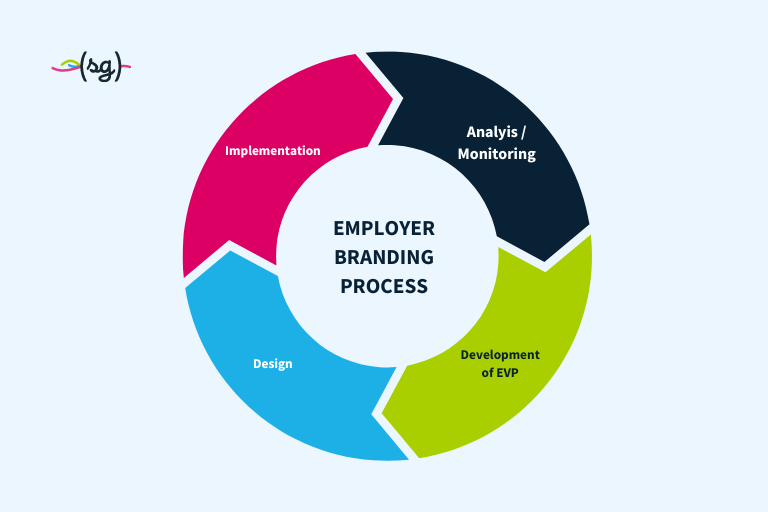
1. Analysis
- Analysis of your own strengths and weaknesses as an employer
- Definition of the relevant target groups
- Researching competitors and best practices
2. Development of the employer value proposition
- Collection of all characteristics that make your company unique as an employer and are important for your target groups
- What values, benefits and development opportunities does your company offer its employees? What sets you apart from other employers?
- Formulation of a clear and concise value proposition, the so-called Employer Value Proposition (EVP), which appeals to the target group emotionally
3. Design of the employer brand
- Development of an action plan based on the employer value proposition that promotes the creation of an authentic employer image
- Definition of messages and stories that bring your employer brand to life
- Visual design of the employer brand: logo, colors, visual language
4. Implementation of the employer brand
- Selection of suitable communication channels: Online (e.g. career site, social media channels, career portals) and offline (e.g. career fairs)
- Development of target group-oriented content that conveys the employer value proposition and the employer brand
- Use of storytelling to emotionally charge the messages
.
5. Monitoring and optimization
- Regular evaluation of the results of your employer branding campaigns.
- Interviewing employees and applicants to obtain feedback and better understand the needs and expectations of these target groups
- Findings serve as the basis for optimizations in the next employer branding cycle
- This iterative approach enables companies to react flexibly to changes in the labor market, increase their own attractiveness as an employer and be successful in the long term. It is a continuous process that requires the active cooperation of everyone involved.
Employer branding measures: Best practices for maximum success
There are a variety of measures that can be used as part of an employer branding strategy. Here are some examples of effective employer branding measures:
1. Career page
- Authentic insights into everyday working life and corporate culture
- Employee portraits and testimonials
- Job advertisements that emphasize benefits and development opportunities
- Mobile optimization for use on smartphones and tablets
2. Social media
- Presence in relevant social networks (e.g. LinkedIn, Instagram, Xing)
- Regular publication of interesting and relevant content
- Use of images, videos and stories to bring the employer brand to life
- Interaction with followers and answering questions
3. Employee referral program
- Rewarding employees who recruit new colleagues
- Use your own employees’ network to reach potential candidates
4. Career events
- Participation in career fairs and recruiting events to make personal contact with applicants
- Organizing your own recruiting formats, e.g. open days, workshops or presentations to make the culture of the company tangible at first hand
5. Employer review portals
- Active use of platforms such as Kununu or Glassdoor
- Transparent response to reviews, both positive and negative
- Use of feedback to continuously improve employer quality
Employer branding with softgarden: Strengthen your employer brand in recruiting
softgarden supports your company in strengthening its own employer brand and being successful in recruiting. With softgarden you benefit from:
- Professional career website: Present your company as an attractive employer with a modern and user-friendly careers website.
- Effective applicant management: Manage your applications efficiently and transparently and offer your candidates a positive applicant experience.
- Targeted recruitment marketing: Reach your target group with the right messages via the right channels.
- Automated processes: Save time and resources by automating recurring recruiting tasks.
Find out more about how softgarden can help your company build a strong employer brand: Strengthening your employer brand in recruiting – with softgarden
Conclusion
In times of a shortage of skilled workers, the importance of employer branding has increased massively. An attractive employer brand has become indispensable for companies in order to compete for qualified employees.
Building an authentic employer brand is important. Communicating relevant messages and implementing appropriate employer branding measures increase the attractiveness of an employer.
In this way, companies can not only attract new talent, but also secure the loyalty and motivation of existing employees in the long term.
FAQ – Employer branding
Employer branding encompasses all of a company’s activities that shape and influence the employer brand.
The design and management of the employer brand have three main objectives:
- The company should be perceived as an attractive employer
- Potential applicants should be made aware of the company
- Existing employees should be retained by the company in the long term
Employer branding can also be described as “employer brand management”.
Managing the employer brand involves building and influencing it through targeted measures. The employer branding process aims to strengthen the attractiveness of the employer brand for specific target groups.
This enables companies not only to attract new talent, but also to secure the loyalty and motivation of existing employees in the long term.
The increasing shortage of skilled workers makes it essential for companies to position themselves as an attractive employer. Traditional recruiting methods often fall short here. Building a strong employer brand through employer branding is becoming increasingly important. It is a decisive factor in the competition for the best specialists.
Employer branding can be divided into two areas: internal and external.
Internal employer branding focuses on the company’s own employees. The aim is to strengthen identification with the company and employee loyalty.
External employer branding, on the other hand, is aimed at potential applicants. By creating a positive external image, the employer image, awareness of the company as an attractive employer should increase. This helps to attract qualified applicants for vacancies.
Employer branding and HR marketing go hand in hand: employer branding ensures a positive employer image. This is the foundation for successful personnel marketing. This uses targeted measures to attract suitable candidates and win them over to the company.
